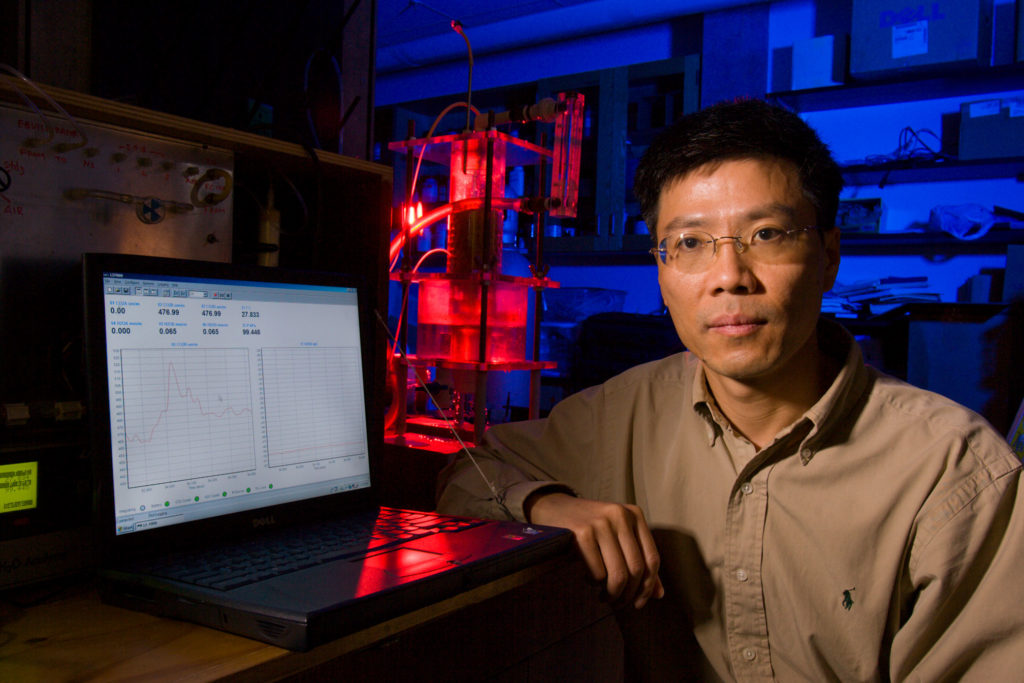These medals are awarded for outstanding UGA identified research or creative activity within the past five years that focuses on a single theme. The 2008 recipients are: Wei-Jun Cai, Jonathan Crystal, Samantha Joye and Phillip Stancil.
Cai, professor of marine sciences, studies the role of the oceans in regulating carbon-dioxide dynamics. Cai realized early in his career that traditional methods of sampling the oceans could not provide spatial and temporal data at the resolutions needed to accurately understand CO2 dynamics. He thus became a pioneer in developing deep-sea microelectrodes and automated shipboard sensors to obtain CO2 information. These new data greatly enhance scientists’ ability to predict global atmospheric CO2 concentrations and, potentially, determine their contribution to global warming. His research has drawn great attention to the role of coastal oceans in regulating CO2 dynamics. Cai challenged the notion that the oceans are simply a large sink for atmospheric carbon dioxide, and he offered a new approach that divides them into subsystems. If confirmed, his view could have major implications for carbon-cycle research and the modeling of global CO2 fluxes.
Crystal, associate professor of psychology, is an international authority on time perception and animal cognition. Using food as a reward, Crystal designed innovative experiments in which he showed that rats have “episodic-like memory”-the ability to recollect unique personal experiences. These findings give researchers an animal model that could help in understanding how humans with Alzheimer’s disease and other neurological disorders lose their memory. Crystal also has shown that rats are capable of metacognition, or an awareness of their own thinking; his is the first research to show that a non-primate species has this reasoning ability. His work has been published in premier journals such as Current Biology, and articles about his research have appeared in several high-profile popular publications, including Newsweek and The New York Times.
Joye, professor of marine sciences, uses innovative experimental approaches for assessing the impacts of climate change and global warming on biological and geological processes, particularly those involving carbon, in coastal ecosystems. Joye’s manipulation of marine sediments has been a powerful contributor to deciphering the myriad interactions between microorganisms and their environment, and her work on the effect of temperature on “community metabolism” in marine environments has made marine scientists rethink many traditional ideas. Joye’s discoveries not only provide critical information that will benefit researchers in developing advanced global-warming models but also are valuable in outreach efforts aimed at helping students and the public understand environmental issues.
Stancil, associate professor of physics and astronomy, is a leader in the application of atomic and molecular dynamics to astrophysics and astrochemistry. Characterized by a coupling of advanced computational and theoretical techniques, his work looks at the atomic and molecular collision processes that underlie important cosmic questions. By performing new calculations of collisions of sulfur and oxygen ions, Stancil and his collaborators showed, for the first time, that Jovian X-ray emissions observed by NASA’s Chandra X-ray Observatory could be explained by ions from Jupiter’s moon Io colliding with the planet’s atmosphere. Other recent work from Stancil’s group uncovered significant errors in widely used calculations for molecular hydrogen and carbon monoxide, which could have important implications for the study of interstellar clouds. His research has resulted in more than $2.4 million in grants and has been in 84 publications, including 43 in the past five years.
